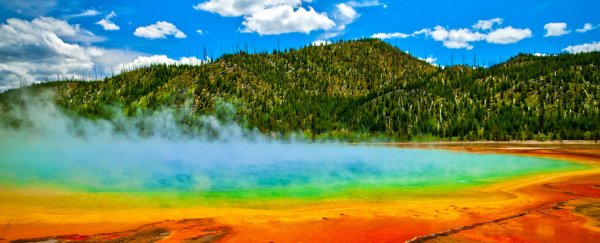Volcanic eruptions inevitably call to mind the mental image of an incredibly hot, molten pool of magma, bursting forth from the ground in an orgy of fiery destruction.
But you might be surprised to know that before the fireworks take place, that super-hot mass of molten rock isn't necessarily super-hot or molten at all – and could instead be trapped in a solidified form of 'cold storage', new research suggests.
"The older view is that there's a long period with a big tank of molten rock in the crust," says geoscientist Nathan Andersen from the University of Wisconsin-Madison.
"A new view is that magma is stored for a long period in a state that is locked, cool, crystalline, and unable to produce an eruption. That dormant system would need a huge infusion of heat to erupt."
Such a huge infusion of heat is what's thought to have unleashed a violent supereruption in California some 765,000 years ago.
This event, which produced the Long Valley Caldera in the east of the state, would have been beyond anything modern humans have seen in terms of volcanic eruptions, casting a layer of debris from the Pacific Ocean to Nebraska.
"It would have completely wiped out everything within 50 kilometres of the caldera," one of the researchers, geologist Brad Singer, told The New York Times.
"All the vegetation and biota in that area would have been extinguished."
But as awesomely destructive as the supereruption was, lingering evidence from the aftermath can tell us about the magma conditions deep underground before the top blew so spectacularly.
Specifically, an analysis of argon isotopes contained in crystals from the Bishop Tuff – the large rocky outcrop produced when the Long Valley Caldera was created – shows the magma from the supereruption was heated rapidly, not slowly simmered.
Geologically speaking, that is – meaning the heating forces that produced the supereruption occurred over decades, or perhaps a couple of centuries. (A long time for people, sure, but a blink of an eye in the life-time of a supervolcano.)
The reasoning is that argon quickly escapes from hot crystals, so it wouldn't have a chance to accumulate in the rock if the rock were super-heated for a long time.
Using a high-precision mass spectrometer, the team found argon isotopes spanning a 16,000-year range from the Bishop Tuff, which suggests argon remained from long before the supereruption took place, meaning the magma would have been cooler for longer, before heating suddenly.
"It must have cooled to the point that it was completely solid," Andersen explained to Newsweek.
"It had to be really a rock, at something more like 400 degrees [Celsius, 750 degrees Fahrenheit]."
Then, changing thermal conditions would have relatively quickly 'thawed' the rock preserved in cold storage, taking the magma to the necessary 700–850 degree Celsius threshold required for an eruption, estimated to have produced something like 650 cubic kilometres of lava and ash.
Unfortunately, while scientists are doing everything they can to read the signs of volcanic supereruptions – something NASA views as more dangerous than asteroid strikes – the reality is, the new findings don't bring us any closer to seeing the future.
"This does not point to prediction in any concrete way," Singer explains in a press statement, "but it does point to the fact that we don't understand what is going on in these systems, in the period of 10 to 1,000 years that precedes a large eruption."
The findings are reported in the Proceedings of the National Academy of Sciences (link down at time of writing).
